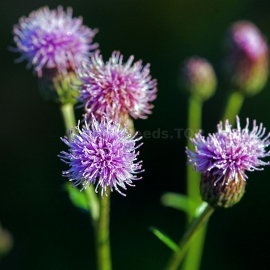



Organic Creeping Thistle Seeds (Cirsium arvense)
1.14 €
Thistles belong to the Thistle Subfamily of the Aster Family, along with artichokes. Compare an artichoke and a thistle, and notice that they are very similar, except in size. Like other members of the Aster Family, these are composite flowers.
-
Organic Creeping Thistle (Cirsium arvense)
Thistles belong to the Thistle Subfamily of the Aster Family, along with artichokes. Compare an artichoke and a thistle, and notice that they are very similar, except in size.
Like other members of the Aster Family, these are composite flowers, with many very small flowers clustered together on a disk, which is typically protected by overlapping layers of bracts. In other words, those are not sepals surrounding the flowerhead, but modified leaves called bracts. With a cooked artichoke, you can peel the bracts off one at a time, dip them in butter and eat the tender base of each one. You could do the same thing with thistles, except that the bracts are too small to bother with.
Uses
The root is tonic, diuretic, astringent, antiphlogistic and hepatic. It has been chewed as a remedy for toothache. A decoction of the roots has been used to treat worms in children. A paste of the roots, combined with an equal quantity of the root paste of Amaranthus spinosus, is used in the treatment of indigestion. The plant contains a volatile alkaloid and a glycoside called cnicin, which has emetic and emmenagogue properties. The leaves are antiphlogistic. They cause inflammation and have irritating properties
Root of first year plants - raw or cooked. Nutritious but rather bland, they are best used in a mixture with other vegetables. The root is likely to be rich in inulin, a starch that cannot be digested by humans. This starch thus passes straight through the digestive system and, in some people, ferments to produce flatulence.
Stems - they are peeled and cooked like asparagus or rhubarb. Leaves - raw or cooked. A fairly bland flavour, but the prickles need to be removed before the leaves can be eaten - not only is this rather fiddly but very little edible leaf remains. The leaves are also used to coagulate plant milks etc.
